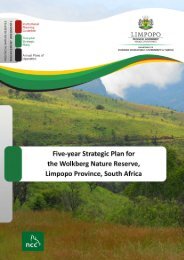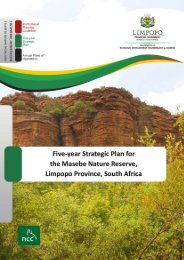Guiding principles for reserve management - NCC Environmental ...
Guiding principles for reserve management - NCC Environmental ...
Guiding principles for reserve management - NCC Environmental ...
Create successful ePaper yourself
Turn your PDF publications into a flip-book with our unique Google optimized e-Paper software.
2.4.3 TopographyThe topography of the <strong>reserve</strong> is characterised by flat to gently undulating plains in the northern andsouthern areas, with a number of hills and isolated koppies located in the central parts of the <strong>reserve</strong>(Figure 3).Altitudes within the WNR vary from 800 m above sea level in the plains to 1 180 m above sea level at itshighest point, which is located on one of the koppies in the central part of the <strong>reserve</strong>.2.4.4 Geology and Soils2.4.4.1 GeologyThe geological <strong>for</strong>mations at the WNR include sandstone, conglomerate, siltstone and shale of theKransberg and Matlabas Subgroups. Gneisses, metasediments and metavolcanic rocks of the MalalaDrift Group, Beit Bridge Complex may also occur, while granite of the Lebowa Granite Suite is alsopresent.2.4.4.2 SoilsThe soils occurring at WNR are sandy and vary from red-yellow apedal high base status to dystrophic ormesotrophic soils.2.4.4.3 Soil ErosionMost of the erosion recorded within the WNR is presumably caused by severely overgrazed areaslocated adjacent to the <strong>reserve</strong> boundaries, notably along the northern, north-eastern and easternboundaries. Sound data on which to base <strong>management</strong> decisions with regard to soil <strong>management</strong> is,however, not currently available <strong>for</strong> the <strong>reserve</strong>.2.4.5 Drainage and HydrologyDrainage within the WNR <strong>for</strong>ms part of the Limpopo River System.A number of small drainage lines can be found within the <strong>reserve</strong>, all of which drain eastward towardsthe Mogalakwena River, which is located along a section of the eastern boundary of the <strong>reserve</strong>. TheMogalakwena River is classified as Critically Endangered and flows northward towards the LimpopoRiver.The WNR is located in a Fish Freshwater Ecosystem Priority Area.A number of fountains or springs, of which the water is used by locals <strong>for</strong> spiritual rituals andceremonies, occur within the boundaries of the <strong>reserve</strong>.The sloping landscape of various parts of the <strong>reserve</strong>, along with the degraded state of some sections,often results in rapid water flow after periods of high rainfall, especially in areas with poor plant cover.The Glen Alpine Dam is located to the east of the <strong>reserve</strong>. This dam is located along the MogalakwenaRiver, and supplies water to irrigation farmers located downstream.LEDET Reserve Management Documents: Wonderkop Nature Reserve (Strategic Plan) 17
















